Fulcrum is a free architectural publication founded in 2011 by Graham Baldwin, Aram Mooradian and Jack Self, as a weekly circular printed on Bedford Press at the Architectural Association. With a vertiginous weekly frequency, Fulcrum offers a platform for both well-known and young writers, to express themselves outside the corporate model. Read by more than six thousand people around the world, some of the published issues explore topics such as ‘Speculation’, ‘Participation’, ‘Property & Ownership’ or ‘Digital Sociability’. Through the 86 issues published to date, available at Fulcrum site, you will find a continuous take that cut across the various contributions and authors, to draw a somehow crowd-sourced political agenda: to think about the agency of the architect as a construct in the late neo-liberal economic model. The four issues produced by Fulcrum as the variant ‘The Commonplace’ on the occasion of the 2012 Venice Architectural Biennale compound a clear picture of the drive that moves the publication forward: to explore many significant social, economical, technological and political subjects through the lens of architecture. We are honored to talk with Fulcrum editor Jack Self about the motivations behind the publication, its distinctive format and distribution, the world of architectural “zines” and our current scarcity of time for reading.
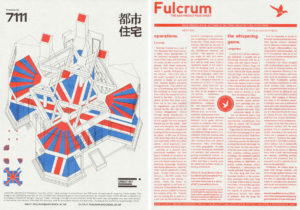
Paula Álvarez: Fulcrum was founded by three students of the AA with high-intentions and an intelligent direction. From its beginnings, you had a clear vocation to contribute to and push cutting-edge debates on the future of architectural profession. Could you tell us more about yours motivations to create Fulcrum? What are the thoughts behind the publication and the topics you have listed in your agenda?
Jack Self: The first thing to say concerns the format. Ten times more people read Fulcrum online than pick it up at the AA – the fact most readers have never seen a copy in real life means I often get asked why we bother to print. The reason for that is simple: a digital format, a blog for example, has an audience that is at once potentially everyone in the world, anywhere, and actually no one in particular. When you make a physical artifact with a limited geographic circulation you are communicating directly with a specific audience. In this case, the initial desire was to introduce a voice to the AA that was absent at the time: a political agenda focused on the culpability of the architect in a process of sinister wealth redistribution over the last forty years. This is why Fulcrum was so heavily involved in the Occupy movement, which is not widely known. We tried very much to highlight the conditions, especially present in Europe, of the profound economic and social inequalities. In short, Fulcrum tries to make some sense of our times.
However, our attitude has never been to simply criticize or critique. Everything must be a proposition: if you are discontent with reality, you cannot simply decry the situation; you must suggest how it might be otherwise. You have to outline an alternative. I would like think that as we have gone along we have got bolder about those propositions, less hesitant to say what we mean, and more determined to drive the political agenda of the publication.
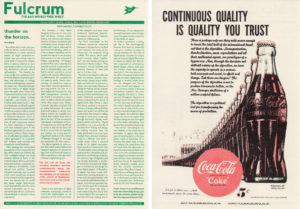
A.: The vertiginous frequency of Fulcrum, with a new and high-quality article every week is quite go-getting and requires a great effort. We are curious about the editorial process, how do you decide the authors and topics?
J.S.: The editorial process is relatively straightforward, and is largely driven by the format. There are no other weekly student publications about architecture that I’m aware of. The reason for the frequency is that it allows you to test or explore many subjects. It also means that some issues are better than others, but the brute force, the relentless, sheer volume of issues means that you always have another chance next week to get closer to what you want to argue for.
Sometimes topics are driven by the work of a particular author, where we pick the writer first and then name the issue afterwards. Sometimes we have a particular subject in mind and then struggle to find someone prepared to write on it. I am still amazed that no one ever sends us articles or topic suggestions – mostly we pick the subjects through gut instinct. What is current? And also, by constantly questioning what it means to be of our times.

A.: In your #51 ‘Life after Fifty’ you and Graham Baldwin took the turn to speak and explain a lot about what was behind Fulcrum. You noted it begun as a response to the increasingly image-based non-critical architectural media and the decline of architectural critique —with a correlating decline in the political agency of the architect. In that scene your intention was to experiment with formats as critical source itself. The physical sheet format offers a playful component, with different articulations between editorial and graphic design. The separation, contrast, and equality of text and image as interchangeable front and backside give the image the status of a subtext, turning the brilliantly simple format into something more complex. What have you been interested in exploring through these features?
J.S.: The most precious thing someone can give you is their time. If they pick up your publication you have an obligation to be succinct, and to get to the point. I also know the world of architecture is generally a time-poor profession. So it has less to do with the internet, with declining attention spans, and so on, and has more to do with not wasting people’s time. You can only make one point with a Fulcrum article, and that’s the ambition —not to be an academic thesis or a meaningless soundbyte, but one, clear statement.
As for the design, it is all about expressing complex concepts in as simple a way possible. Graham Baldwin is the one responsible for our first design, and it was his idea to draw a line down the middle of the page —this simple gesture reflected perfectly the concept behind the publication, which is to act literally as a fulcrum (a pivot around which two authors can discuss a common subject), and also a metaphorical fulcrum— to precipitate a tipping point in student architectural publishing, to take it to the next level, to bring it into the 21st century.
The full-page image on the back lends endless possibilities for a third, silent discussion that often runs between issues as well as within the subject at hand. Yes, we want to be taken seriously, but we shouldn’t be too serious. It’s just a sheet of paper after all. When I redesigned the publication at issue 50, it was just part of the ongoing attempt at refinement, at simplicity, at expressing more clearly the impetus of the publication. I think there is also a clear link between typography and architecture. Composition is essentially universal to both disciplines, and I have tried to treat Fulcrum with the precision of a plan.
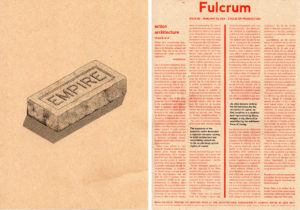
A.: Fulcrum’s short extension and online distribution seems to be in accordance with the new reading habits and formats emerged with the rise of the Internet, but Fulcrum physicality and offline distribution insist in the power of printed matter to spread a message. What value do you concede to the combination of offline and online distribution? What influence do you think Fulcrum has in the AA community?
J.S.: With regards to audience, Fulcrum has become a strange phenomenon. The only reason we started scanning and putting them online was to offer AA students the chance to read issues they had missed. But it quickly became apparent that in fact students outside the school were reading it too. Now, most of our audience is online, which gives a fairly anachronistic feel to the fact it’s a scanned PDF. If I had known this would have happened when I started, I probably would have tried to think of a more appropriate delivery platform, or maybe even done a different type of publication altogether. But that wasn’t what happened, and having started we continued to execute 100 issues unchanged from our original plan.
The value of printed matter, apart from the point I made about geographical audience and targeting specific people, is its spatiality. This is why I have a hard time imagining replacing my books with e-texts. When I look at the bookcase there is a spatial connection between ideas and different subjects that I would not have seen if they were on a screen. When the (currently 86) issues of Fulcrum are all spread about together suddenly new possibilities for discussion and exploration occur, possibilities that are hard to replicate with the digital…
It is extremely hard to tell what the influence of Fulcrum is at the AA, if any… It occupies a very ambiguous position, since it is not at all perceived as institutional. I really couldn’t say, and in a way, it’s not for me to speculate… hopefully someone is reading it though!
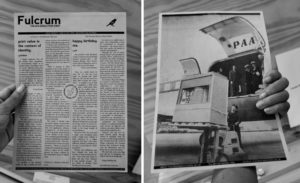
A.: I first heard about Fulcrum with the Archizines touring exhibition, curated by Elias Redstone and which featured architecture magazines, fanzines and journals from over twenty countries that provide an alternative to the established architectural press. Archizines was launched in collaboration of the AA almost a year after Fulcrum was founded. We could perhaps read it as an indicator of Fulcrum influence… But what I am not really sure is about the reappearance of the fanzine as a contemporary phenomenon, do you think it is generational, or is the ease of flow of information on the internet what is making it visible a type of editorial project that has been always there?
J.S.: I would suggest that there are more zines today than, say, ten years ago, for two reasons. The first is that the blogosphere has been largely corporatized. In the mid-2000s there were many independent architecture blogs of a very high standard: BLDG BLOG, Things Magazine, Demilit, Mammoth, and so on. Today, the writers who would have become the new bloggers have been sucked up into corporate mechanisms: the BLDG BLOGs of today are now the official architecture bloggers for the Guardian, the New York Times, ArchDaily, Dezeen, etc. The quality hasn’t changed, but the independence and focus —as well as the propositional possibilities of blogs— have changed significantly. As a result, there are more zines, which struggle against this situation with the blogs, and there are more text-free tumblrs: architectureofdoom, archiveofaffinities, polychroniadis, fuckyeahbrutalism, to name only a few.
The notion of “fanzine” is, however, problematic. The first question I would ask is: “fans” of what? I would not categorize Fulcrum as a fanzine – to declare oneself a “fan” of anyone or thing is immediately to establish a hierarchy. A “fan” can never become a peer. I prefer the term “admirer” —one can admire the work of an equal without deprecating oneself to the status of fan. In any case, as I said, it is not clear what these small magazines are actually fans of… Fulcrum is unusual, since it has content that might suit a blog, but by resisting institutionalization, categorization or corporatization, it has no interest in the politics of contemporary architectural publishing. I don’t care that it’s not peer reviewed, or academic. But it’s certainly the highest quality material we can manage, it is fastidiously proofed, checked and edited, and very tightly controlled —in this sense, the care we take is much higher than the majority of magazines or blogs. We aspire to be professional about this shit, because the ideas we try to promote should be taken seriously.
There is of course something frustrating about exhibitions like Archizines, which are neither able to act as archives or repositories of the full zine (that is, for numerous reasons, amongst them copyright, they can’t scan and provide full text or image versions), nor do they have enough physical space in the exhibition to display the full collection. One has to, in a sense, guess at what the full collection might look like, and only Elias and his team know for sure what they have. This incompleteness is not necessarily a downside; it represents the impossibility of comprehensively documenting such ephemeral material as zines.
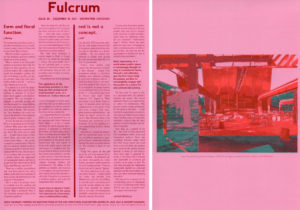
A.: I know what you mean. I remember watching the videos to find out more about the zines featured, and feeling a little bit frustrated because the more publications were featured, the shorter was the time conceded to editors and creators to talk about them. On the other hand, I missed some Spanish architectural well-known little zines… But it was a great way to learn about publications I would not have heard of otherwise, and it gives a broad appreciation of what’s going on in an international scale. Now that we talk about architectural magazines, I am curious about your preferences…
J.S.: I only read Architectural Review, for whom I’ve worked for several years. It is by far the best place for finding out what architecture means. To keep up with recent projects, news, gossip, etc, I use Twitter and the web… There are a number of other independent magazines of exceptional quality, as diverse as Log, 032c, or Apartamento, for example, but I can’t find the time, unfortunately, to read them regularly – and there are a couple more which are not always in English that I like very much but cannot understand completely. This is certainly something I would have liked to do with Fulcrum, and that is have it translated and printed simultaneously in several languages – Spanish, Italian, Japanese, for example, because in the globalized architecture scene you can’t expect everyone will read English. The problem is that at its base, Fulcrum was only ever intended for a few hundred kids at the AA…
A.: To exceed one’s expectations is never an accident! Thanks a lot, it was really a pleasure to learn more about Fulcrum and to talk with you.
Seville / London 2014.
Enjoy Fulcrum online archive here.
